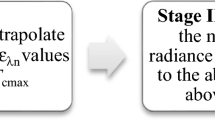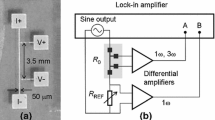Abstract
Modern diagnostic tools offer a new approach to solving thermophysical problems, considerably saving measurement time: those measurements that previously required hours can now be made in just a few minutes A procedure is proposed for determining the emissivity of a thin metal wire within several minutes in the regime of unsteady-state heat conduction. Many researchers, including G.M. Kondrat’ev, who proposed to determine the emissivity by the regular regime method, tried to implement this procedure in practice but faced technical problems inherent in experimental work, including the requirements for high vacuum and taking measurements using fast-response instruments. Technical difficulties forced researchers to limit the temperature range, increase the experiment time, or perform computer simulations of the heating-cooling process. This procedure can be implemented in practice due to the use of a fast-response measurement system based on an Arduino Uno microcontroller and an L-Card E14-140 analog-to-digital converter capable of recording signals at 40 ms intervals. Lithium-ion batteries were used to miniaturize the unit and reduce the interference level. The values of emissivity of a tungsten wire with an oxidized surface, determined by the selected and the calorimetric method in the temperature range of 400–870 K, are in good agreement. The temperature range is limited only by the voltage of the used battery.



Similar content being viewed by others
REFERENCES
V. P. Isachenko, V. A. Osipova, and A. S. Sukomel, Heat Transfer (Energiya, Moscow, 1975; Mir, Moscow, 1980).
Emittance Properties of Solid Materials: Handbook, Ed. by A. E. Sheidlin (Energiya, Moscow, 1974) [in Russian].
A. V. Kostanovskii, M. G. Zeodinov, and M. E. Kostanovskaya, “Thermal conductivity and emittance properties of DE-24 graphite at temperature range of 2300–3000 K,” Izmer. Tekh., No. 12, 38–44 (2010).
A. V. Kostanovskiy, M. G. Zeodinov, M. E. Kostanovskaya, and A. A. Pronkin, “Emittance properties of siliconized silicon carbide in the temperature range of 1400–2200 K,” High Temp. 57, 272–274 (2019).
G. M. Kondrat’ev, The Regular Thermal Regime (Gostekhizdat, Moscow, 1954) [in Russian].
V. A. Osipova, “Determination of the emissivity of metals by the regular thermal regime method,” Teploenergetika, No. 4, 59–63 (1958).
V. M. Uvarov, E. S. Gromova, and G. G. Khokhlov, “On determination of the emissivity of a body,” Nats. Assots. Uch., No. 52, 53–54 (2020).
V. A. Arkhipov, I. K. Zharova, V. D. Gol’din, N. I. Kurilenko, and G. Ya. Mamontov, “Analysis of the non-stationary method for measuring the integral emissivity,” Teplofiz. Aeromekh. 19, 751–760 (2012).
E. V. Lapovok, D. A. Mosin, M. M. Pen’kov, I. A. Urtmintsev, and S. I. Khankov, “Measurement of the emissivity of sample surfaces by the method of monotonous heating,” Izv. Vyssh. Uchebn. Zaved., Priborostr. 59, 311–316 (2016).
A. G. Romashin, A. A. Borzykh, B. E. Tikhonov, V. G. Verevka, and Yu. M. Potapov, “Measurement of the emissivity of inorganic materials on small samples,” Teplofiz. Vys. Temp. 9, 517–521 (1971).
V. E. Zinov’ev, Handbook of Thermophysical Properties of Metals at High Temperatures (Metallurgiya, Moscow, 1989; Nova Science, New York, 1996).
Author information
Authors and Affiliations
Corresponding author
Additional information
Translated by T. Krasnoshchekova
Rights and permissions
About this article
Cite this article
Zeodinov, M.G., Pronkin, A.A. & Krynitskaya, D.A. Investigation into the Emissivity of a Thin Tungsten Wire with Oxidized Surface in the Unsteady Heat Conduction Regime. Therm. Eng. 70, 210–214 (2023). https://doi.org/10.1134/S0040601523030084
Received:
Revised:
Accepted:
Published:
Issue Date:
DOI: https://doi.org/10.1134/S0040601523030084




